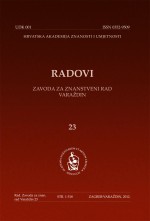UTJELOVLJENA ENERGIJA I PROCJENA UKUPNE ENERGIJE U ŽIVOTNOM VIJEKU ZGRADE: STUDIJA SAMOSTOJEĆE OBITELJSKE KUĆE
EMBODIED ENERGY AND LIFE-CYCLE ENERGY ANALYSIS: A CASE STUDY OF A DETACHED HOUSE
Author(s): Antonija BogadiSubject(s): Economy
Published by: Hrvatska akademija znanosti i umjetnosti - Zavod za znanstveni rad Varaždin
Keywords: lifetime building energy assessment; embodied energy; detached house; Croatia.
Summary/Abstract: Buildings imply energy consumption in their life cycle, right from the excavation, transport and production of the construction material, up to the energy demanded for their construction, maintenance and demolition. Studies on energy use during the different phases in life cycle of the building could identify phases of the largest energy use and related greengases emissions to develop target strategies for their reduction. Kyoto target obligations necessitating the quantification of greenhouse gas emissions at the national level caused the growing need of the usage of this kind of an analyses. The method of assessing lifetime building energy and its environmental impact is known as Life-Cycle Energy Analysis, though the final agreement and standards for the scope of the monitored system have not been yet achieved. This paper briefly explains Life-Cycle Energy Analysis method as well as associated terminology providing an embodied energy and life cycle energy assessment of a detached house in Varaždin, Croatia. Main construction materials i.e. aluminium, glass, concrete and clay blocks have been analysed to determine building’s embodied energy. Embodied energy of the various construction materials involved has been estimated to be equal to 303,60 GJ, and it is also found that clay blocks, mineral wool and steel sheet are the three most energetically expensive materials. Furthermore, results show expected importance of the operating energy (83%) as well as the significance of the embodied energy (17%) in building’s life cycle energy demand. Operating energy share in total lifetime building energy is anticipated to decrease through efficiency improvements and lifestyle changes, so the significance of the embodied energy value will increase. The case study illustrates how particular design strategies make a significant impact on building’s embodied energy and life cycle energy. The aim of this study is to compare embodied energy in different building materials and to demonstrate Life Cycle Energy Assessment on the studied house.
Journal: Radovi Zavoda za znanstveni rad Varaždin
- Issue Year: 2012
- Issue No: 23
- Page Range: 491-505
- Page Count: 16
- Language: Croatian

